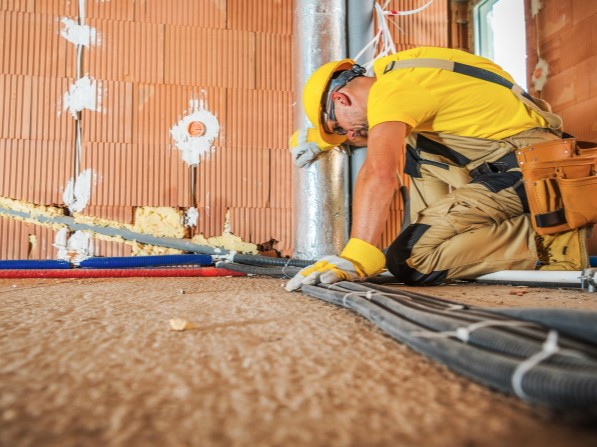Posted by AP Construction, AssuredPartners A Wrap Up or a controlled/consolidated insurance program (CIP), or wrap up, is a centrally procured and managed insurance and risk control program implemented for a construction project or a series of projects. CIPs can be purchased by the owner, an Owner Controlled Insurance Program (OCIP), or the general contractor, a Contractor Controlled Insurance Program (CCIP). Read AssuredPartners’ full article here: Controlled Insurance Programs: Is it the Right Choice for Your Construction Project?
Best Practices for an Effective Construction Risk Management Program
Posted by Gary Semmer, AssuredPartners The construction industry continues to face material price increases, supply chain interruptions and delays, and labor shortages that affect scheduling and profitability and cause job-site delays – all of which are described as the “new” norm. We recognize that you have little if any, control over these factors; however, there are things you can do to control your insurance cost, including: Safety Program/ OSHA Compliance: Accident prevention is a cornerstone of a solid Risk Management (RM) program. Periodically you should review your safety manual, safety orientation and training, and OSHA compliance to reduce employee injuries, job-site claims, and vehicle accidents. Safety is a top-down priority and needs to be communicated throughout the organization. Share …
Surety Bonding 101: Understanding the Basics
Posted by AP Construction & Surety, AssuredPartners Surety bonding is a crucial aspect of many industries, from construction to finance. But what exactly is surety bonding, and why is it so important? This article will explore the basics of surety bonding and provide valuable insights into how it works. What is Surety Bonding? Surety bonding is a type of insurance that guarantees the performance of a contract or obligation. In other words, it’s a way for businesses to ensure they will fulfill their promises to clients or partners. Surety bonds are typically required in industries where large sums of money are at stake, such as construction, finance, and government contracting. How Does Surety Bonding Work? When a business obtains a …
Developing Enduring Trust in the Construction Risk and Surety Industry
Posted by David Bradbury, AssuredPartners Throughout history, all enduring progress in our world began with a vision, was refined by a concept, and was created based on a solid foundation, teamwork, and a plan to grow and prosper. Along the way, our industry has learned the valuable lesson that interdependent and interdisciplinary relationships, earned trust, and adherence to solid core values, ethical standards, and consistently adopting innovative construction and risk solutions, become the necessary foundation for sustaining success in the 21st century. To that end, contractors today require much more than traditional insurance, surety, risk management and claims services from their broker. The complexities of the present construction environment demand the engagement and services of a professional business partner/broker who will make …
When Construction Counts – Addressing Subcontractor Challenges
By AP Construction and Surety Team for AssuredPartners Construction is a trillion-dollar industry, but construction can’t happen without subcontractors. With specialized skills, such as plumbing, electrical work, carpentry, and roofing, subcontractors allow general contractors to focus on managing the projects while adjusting their workforce to meet project demands. Because subcontractors are a vital part of the construction industry, it’s important to recognize and address their challenges. Macroeconomic challenges, most notably labor shortages and material costs, are having the most significant impact. While the increase in labor costs is significant, finding enough skilled labor is predicted to be the most considerable risk this year. The trillion-dollar infrastructure bill, compounded with the regular flow of projects, means that hundreds of thousands of …
What Determines the Cost of a Surety Bond?
By Sarah Licata for AssuredPartners The price of surety bonds can vary greatly, and many people are unclear of why this is. When determining premium, surety companies are looking to determine the amount of risk there is with an applicant by considering at a variety of indicating factors. Below are some key factors that may be considered when determining bond premium. Type of Surety Bond There are many different types of surety bonds and the type of bond required can vary in price. This is due to the fact that each surety bond guarantees a unique risk, and the level of risk the surety company is taking on is factored into the premium. In short, the higher the level of …
2023 Construction Conference Guide
By Sarah Licata for AssuredPartners With an ever-changing landscape facing the construction industry, keeping up to date by getting advice from industry experts makes navigating the challenges that come your way a little easier. Our construction and surety experts often attend conventions and other industry events to get the latest information on what is happening so that they can best serve you. Interested in possibly attending an event in 2023? Check out the list below for some options to get you started on finding the best event for you. Please Note: Check conference websites linked below for more information and the most current schedule. The Associated General Contractors of America Convention When: March 13-16 Where: Las Vegas, NV About: “Experience …
Best Practices for Risk Management
By Gary Semmer for AssuredPartners The construction industry is facing a number of “external” challenges ranging from materials price inflation, supply chain delays, and labor shortages which translates into scheduling, productivity, and profitability issues. Although we have no control over these external factors, we can help our construction clients control the following equation: Total Cost of Risk (TCOR) Premiums + Deductibles + Risk Management Expenses/Construction Revenues= .0050% to 1.5% (acceptable range) and maintain a competitive advantage. Let’s explore the “Best Practices” of a Risk Management Program to achieve these results: See these results here>>>
News Release From OSHA & U.S. Department of Labor
By Kyp Ross for AssuredPartners On July 14th, 2022 the U.S. Department of Labor’s Occupational Safety and Health Administration (OSHA) issued a press release regarding an uptick in fatalities. The press release, titled “Alarming rise in trench-related fatalities spurs US Department of Labor to announce enhanced nationwide enforcement, additional oversight” announced that during the first half of 2022, 22 workers have been victims of deadly hazards involving a trench and/or excavation work. This number is alarmingly high, as there were a total of 15 fatalities in all of 2021. With this unfortunately high number, OSHA is evaluating the tools at their disposal to protect workers and keep safe working conditions. In additional to asking employers involved in trenching and excavating activities …
Cybersecurity and the Construction Industry
Written by Sarah Licata for AssuredPartners Every industry is susceptible to cyber security risks, and the construction industry is no exception. The construction industry is largely unregulated when it comes to cybersecurity, so many companies fail to prioritize this issue. Many believe that their company doesn’t have anything a hacker could want, when in fact they hold sensitive information such as proprietary data, employee records, project designs, bid pricing, financial records, contracts, and more. In order to protect themselves, construction companies need to have safeguards in place to prevent and react to any cyber-attacks as they increasingly rely on technology. So, what steps can you take to protect your company? Click for prevention strategies>>>










